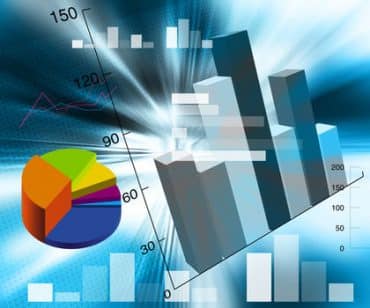Forecasting sales is an important business exercise. Accurate sales forecast enable business leaders to make better decisions regarding goal-setting, budgeting, hiring, and other cash-flow-related issues.
Meanwhile, erroneous sales forecasting methods leave sales managers unsure whether they will meet their quota. As a result, they may not detect any problems in the sales pipeline in time to correct them.
Let’s take a look at what sales forecasting is and some of the fundamentals you’ll need to get it correctly. Also, we’ll see some real-world example of sales forecasting to help us understand better the concept
What is Sales Forecasting?
Sales forecasting is the projection of future revenue from sales. Forecasts for sales are often based on historical data, industry trends, and the current state of the sales pipeline. The sales forecast is used by businesses to estimate weekly, monthly, quarterly, and annual sales totals.
Your sales forecast, like a weather forecast, should be viewed as a plan to work from rather than a hard prediction.
Sales forecasting is not the same as setting sales goals. A sales objective outlines what you desire to achieve, whereas a sales forecast predicts what will happen regardless of your goal.
What you need to know for Accurate Sales Forecasting
The most critical criterion for a strong sales forecast is good data. As a result, obtaining reliable data is critical.
New enterprises that lack data on their own sales process may have to rely on industry statistics or even informed guesswork. More established businesses, on the other hand, can use historical data to forecast future success.
Before you start thinking about how to anticipate revenue, here’s what you need to accomplish first:
#1. Make a record of your sales process.
You won’t be able to forecast if any single deal will complete unless you have a fully written sales process that describes the actions and procedures required to conclude a deal.
#2. Set your sales targets or quotas.
While your prognosis may differ from your goals, you won’t know whether your forecast is excellent or terrible unless you first establish a target. As a result, each rep, as well as the entire sales team, requires an individual quota. More information on setting sales objectives or quotas can be found here.
#3. Establish a baseline or current average of certain basic sales indicators.
Forecasting will be significantly easier if the following basic sales metrics are publicly accessible:
- The length of time it takes for a customer to indicate interest
- How long does it take to complete a transaction?
- The average cost of a transaction
- The length of time it takes to onboard a new customer.
- Average renewal or rate, or the frequency with which you receive repeat business
Conversion rates are calculated at each stage of the sales process. Essentially, you want to identify your sales process’s average length and performance.
#4. Learn about your current sales funnel.
Ensure that you understand what is currently in your pipeline and that your CRM is correct and up to date. Forecasting is more difficult, but not impossible, if you do not have a CRM.
Let’s seethe different sales forecasting methods in the next section.
Sales Forecasting Methods
There are various methods for forecasting sales. Many firms use two or more sales forecasting methods to generate a variety of forecasts. As a result, they have a best-case and a worst-case situation.
Methods for sales forecasting that are commonly used include:
#1. Relying on the advice of sales representatives
Many sales managers simply ask their agents, “When is this deal going to close, and how much is it going to close for?” ”
While this is a strategy for attempting to build a sales prediction, it is not recommended. Sales representatives have a tendency to overstate sales projections, and there is no repeatable technique for producing a consistent forecast using this strategy. Unfortunately, many firms continue to use this strategy to forecast future sales.
#2. Using historical information
You use a record of your past performance under similar situations to estimate how you’ll do in the present with this strategy. For example, you may be aware that your company grows at a rate of 15% year over year and that you closed $100k in new business this month last year. As a result, you estimate $115,000 in income this month.
This method is marginally more accurate, but it ignores other aspects that may have changed in the last year, such as the amount of sales representatives you have or how your competitors are performing.
#3. Using transaction stages
You assign a likelihood of closing a contract to each stage of your sales process in this forecasting strategy. Then, at any given time, you may multiply that chance by the magnitude of an opportunity to predict the revenue you can expect.
This forecasting method is even better and more popular due to its simplicity. It does, however, contain a flaw: it disregards the age of the opportunity. Is it true that if two opportunities have scheduled a sales demo, but one is three weeks old and the other is three months old, they are equally likely to close?
#4. Forecasting the sales cycle
As a result, an alternative forecasting strategy is to measure the strength of the pipeline based on the age of the sales opportunity rather than the probability.
It compares the length of time a deal has been in the pipeline to the average time it takes to close a contract. If you have different goods and sales cycles based on whether you received a referral or are following up on a lead from prospecting, you’ll need to break things out to generate an estimate for how likely a deal is to close.
This procedure requires precise data. Everything must be appropriately logged in the CRM so that you can see what type of lead it is and how long it has been in the system. If you don’t have a CRM that can record all of that fast and easily, your reps may have to enter a lot of data.
#5. Forecasting of pipelines
This method is far more accurate, although it is still dependent on high-quality data. It examines each opportunity in your pipeline and analyzes it based on a variety of factors like as age, deal type, and deal stage.
Because this is a pretty advanced strategy, it is unlikely to operate without bespoke tools capable of analyzing what is in your pipeline.
#6. Using a bespoke forecast model that includes lead scoring and various variables
This forecasting method is based on a mixture of the aforementioned factors. It is comparable to the pipeline forecasting method, however it is more in depth and sophisticated. Typically, an analytics tool or advanced CRM reports would be required to assist in the creation of these forecasts. You also need exceptionally solid data to begin with, thus you rely on your reps to submit a large amount of reliable information.
This form of sales forecasting can be the most accurate if you have those resources. You can also consider an opportunity’s age, the present state in the sales process, prospect traits that make them more inclined to purchase, and other factors. now that we have seen the different sales forecasting methods, let’s a real-world example of the sales forecasting software.
Sales Forecasting Example
Reading about predicting isn’t always as beneficial as looking at examples. Here is some fundamental hypothetical example to consider to understand how sales forecasting works in the real world.
Example 1: Forecasting Using Historical Sales Data
Assume you had $150,000 in monthly recurring revenue last month and that your sales revenue has risen at a rate of 12% per month over the last 12 months. During the same time span, your monthly churn has averaged around 1%.
Your projected revenue for the following month is $166,500.
You multiply the previous month’s income by your predicted growth and deduct your expected churn:
$166,500 = ($150,000 * 1.12) – ($150,000 *.01)
Example 2: Sales Forecasting Using Your Existing Funnel
Assume you have three open positions this month:
- One in which you made a brief phone call with an expected value of $1,000.
- One that has received a thorough demo and is believed to be worth $1,500.
- And one with an offer, with a $1,200 estimated value.
You’ve done your homework, and you know that at each of these stages, any given opportunity has the following chances of closing:
“Connect Call” equals a 30% likelihood of closure.
“Demo” indicates a 40% chance of shutting.
“Offer” indicates a 70% likelihood of closing.
You multiply that chance by the predicted value of the contract and add them all up to get a total sales prediction of $1,740, as shown in the following example:

Example 3: Sales Forecasting Using Lead Scores and Multiple Variables
You’ve done your homework and have lead scoring set up in your CRM. Your leads are divided into three groups of varying quality: A, B, and C. These factors influence the likelihood of a deal closing.
You’re also aware that businesses with fewer than 50 employees close at a little lower rate, whereas businesses with more than 50 employees are more likely to close.
Using a table like this, you could then use average opportunity sizes to calculate the anticipated value of any specific chance:

Tools for Sales Forecasting
#1. CRM software
combines a database’s storage and retrieval power with specialized sales features that assist salespeople in closing deals. Lead tracking, funnel analytics, call sequences, and reporting capabilities are examples of such features. You must select a CRM based on the size and nature of your company. There are numerous things you can do to get the most of your CRM.
#2. Excel:
If your firm is new or only has a few products, spreadsheet tools such as Excel should sufficient for creating a sales estimate. It’s versatile, conditional, and allows you to create amazing charts for a low cost. However, it is time-consuming and prone to errors, thus it may not be suitable for a larger operation.
#3. Sales Analytics Platforms:
Sales analytics platforms aggregate data for several products and services, generate projections, and provide in-depth analytics. In addition, several include useful graphs and charts. Dedicated analytics tools also offer the advantage of being constantly updated. They can provide more detailed information about sales funnels, products, and employee performance. Also, they can provide further information about any gaps in the procedure. They can assist with everything from identifying development possibilities to determining which team members to assign to which clients.
#4. Lead Scoring Tools:
Lead scoring tools assist you in determining which prospects are worth pursuing sales and what priority to assign to them. They enable you to grade prospects based on website activities, conversation outcomes, and any other touches that your team feels relevant to the sales process. A lead scoring tool can also assist your marketing team with campaign segmentation by identifying who is ready and willing to buy and who need additional work, as well as the level and reason for involvement. It can also aid in content customization by identifying the prospect’s current degree of interest in your company as well as the areas in which the prospect has previously expressed interest.
#5. Tools for project management and resource allocation:
The most critical component of your sales cycle is follow-through, and it is the only way to develop strong client connections. Project management tools keep your team on track and ensure that they have the resources they need to complete the project. Project management software eliminates much of the human labor involved in recording what has been done and when. They may also allow for easier integration with other teams that use the same technologies.
#6. Accounting Software:
If all you need is a new revenue forecast, simpler solutions will suffice. However, the value of a sale is determined not just by the amount of the transaction, but also by the costs it incurs elsewhere in the firm. To generate truly accurate sales estimates, you must first comprehend the ripple effect. You may need to integrate data from your accounting software in your forecasting exercise if you want to anticipate gross margins and account for the cost of goods sold.
Conclusion
Sales forecasting is an informed guess about future sales income that employs historical data and common sense to project a company’s monthly, quarterly, and annual sales totals. Your team should see the sales projection as a guideline to follow rather than a solid prediction.
Estimate the length of your average sales cycle and conversion rate before attempting to develop sales forecast. Forecasts can be constructed in a variety of ways. In your business, try out different methods for sales forecasting precision.
What Are the 4 Basic Forecasting Method?
There are a lot of tools that can be used to make quantitative budget forecasts, but this article focuses on four main ones:
- straight-line,
- moving average,
- simple linear regression,
- multiple linear regression.
Why Is Sales Forecasting?
Sales forecasting enables businesses use their resources well for future growth and keep track of their cash flow. Sales forecasting also helps businesses get accurate estimates of their costs and income, which lets them predict their short-term and long-term performance.
What Are Sales Forecasting Examples?
History-based forecasting, opportunity stage forecasting, length of sales cycle forecasting, multivariable forecasting, and pipeline forecasting are all common examplees of sales forecasting.
What Are the 2 Main Methods of Forecasting?
There are two different ways to make forecasts: qualitative and quantitative. Each type is good for different things, so you need to choose the one that will help you reach your goals. And knowing all the methods will help you choose the one that will give your business the most useful information.
- Fortune 500: Definition, Techniques, & Factors for Ranking
- Demand Forecasting: Methods, Examples, Models (+ Detailed Guide)
- Cash Flow Forecasting: Meaning, Methods, Tools, Models (+ Detailed Templates)
- Competitive Pricing: How to do Competitive Pricing Analysis
- CUSTOMER RELATIONSHIP MANAGEMENT (CRM): Definition, Tools, and Importance






